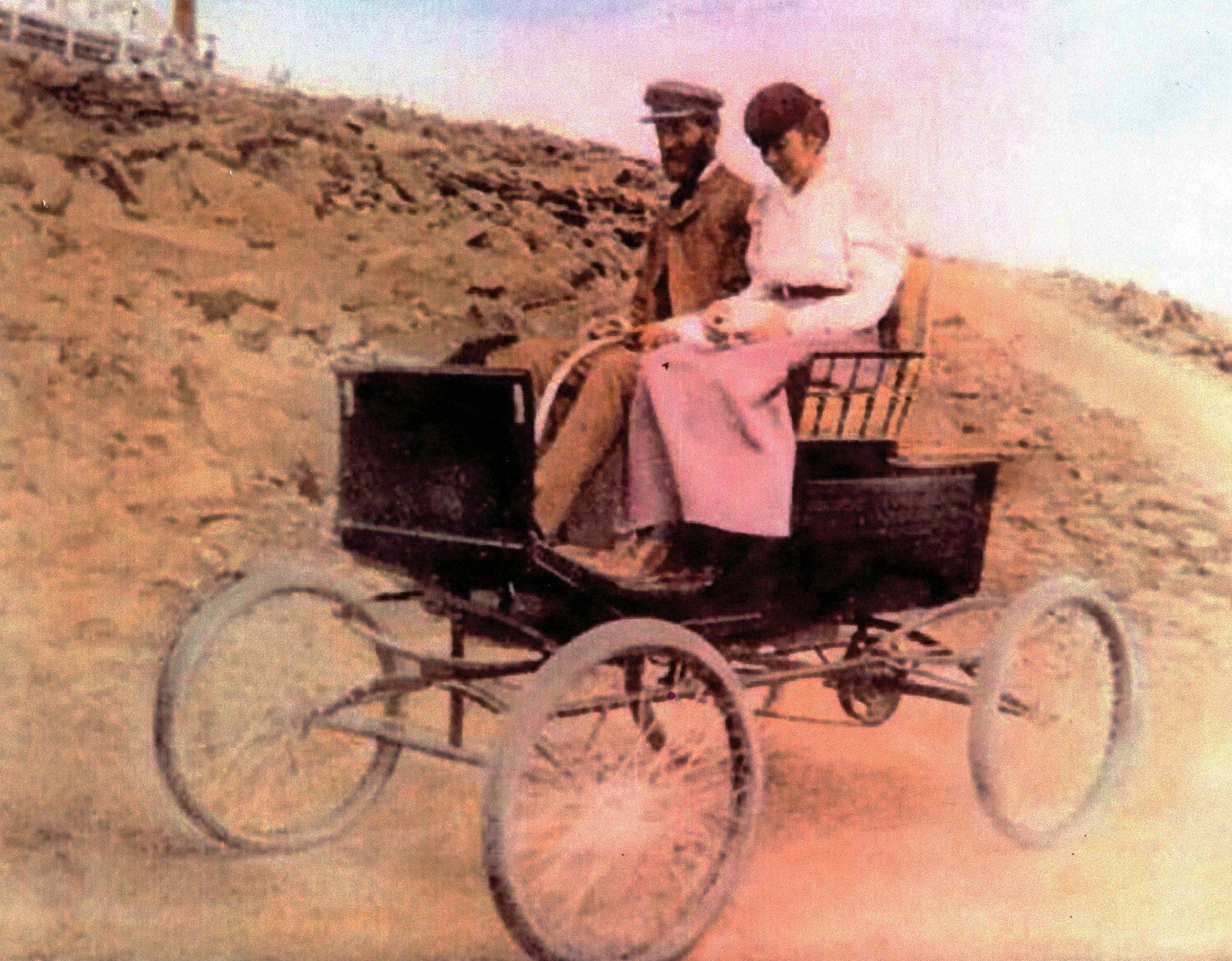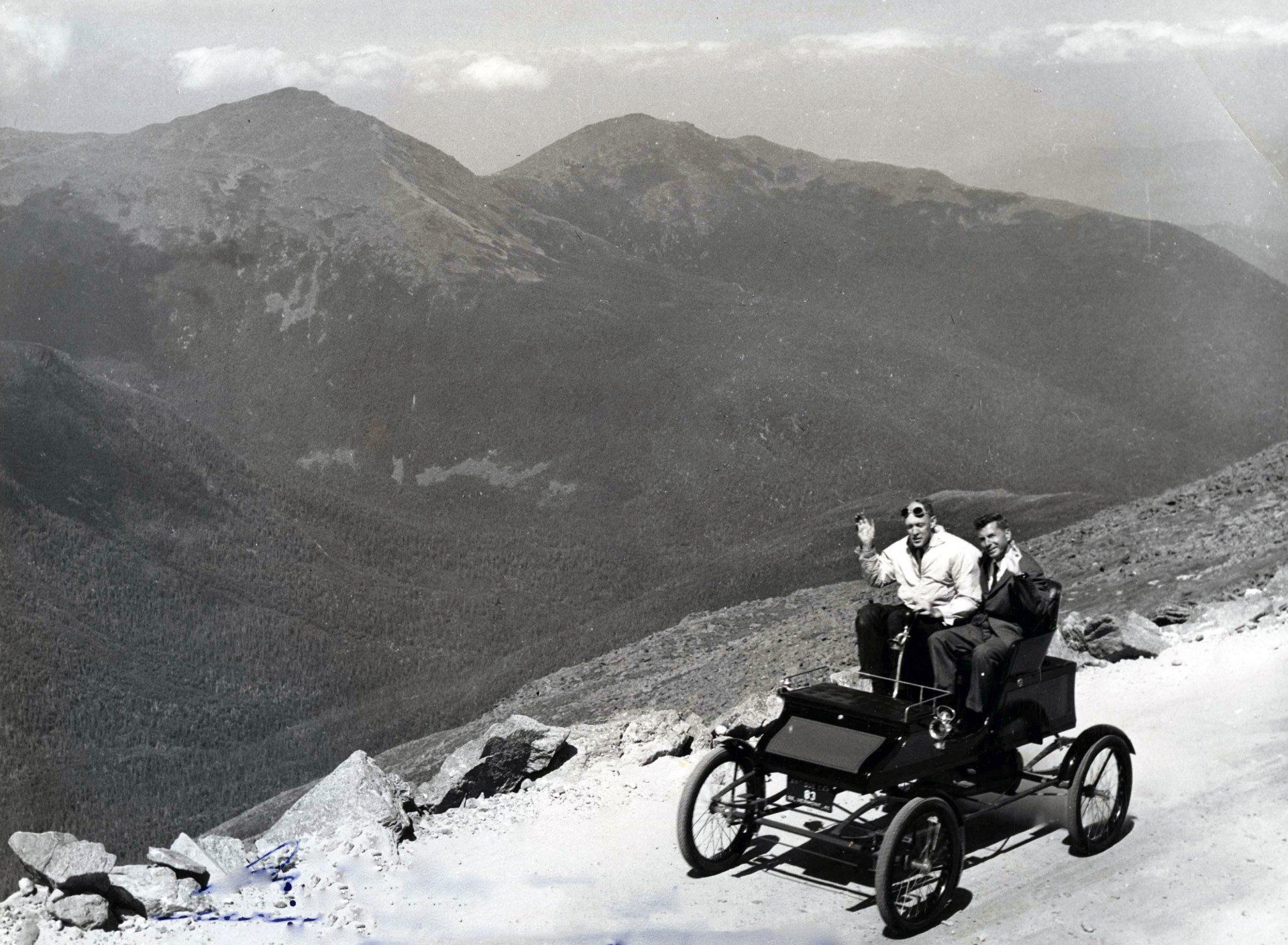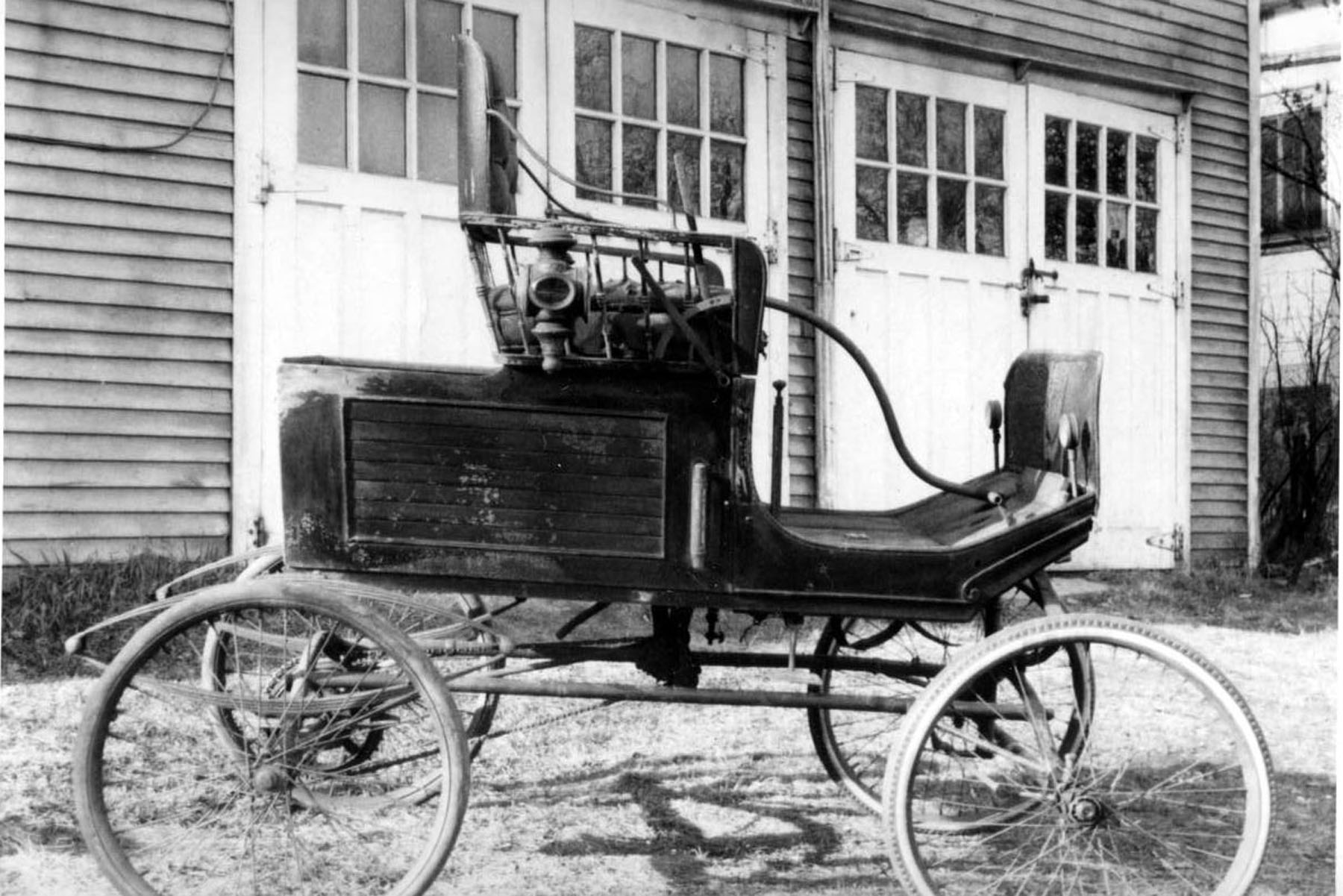Locomobiles, Stanley Steamers and the Climb to the Top of Mt. Washington
In the late 1890s many of the new horseless carriages were steam powered, not internal combustion engines like today’s cars. The twin Stanley Brothers, Francis and Freelan, produced 100 steam cars in 1899. They were called Locomobiles and were a two passenger, buggy style car, made of light weight, tubular construction like that of a bicycle. Edwin found our 1899 Locomobile in 1948 it in a partly collapsed shed that housed a bicycle shop in Albany, NY. It is Serial No. 1, the first one made.

Freelan and Flora Stanley near the top of Mt. Washington
on August 31, 1899.
on August 31, 1899.
Introduction
The Stanley Brothers sold their Locomobile business later that year because of patent infringement and in 1901 started the Stanley Motor Carriage Company. Their Stanley steamer is a different car than the 1899 buggy. It’s a 4-passenger “wagon” with a similar sized engine and has wooden rods replacing some of metal tube frame. The earlier cars of this series are chain driven, engine-to-rear axle. Later ones have engines directly coupled to the axle, a considerable improvement. Edwin found our chain drive 1901 Stanley in 1942 stored in a barn in Rutland, Vermont, it is the earliest Stanley known to exist and is Serial No. 134.
On August 31, 1899, Freelan Stanley and his wife Flora, in what was probably a clever advertisement move, drove their Locomobile steamer up the Summit Road to the top of Mt. Washington, New England’s tallest peak at 6288 feet. Flora wrote a short book about that experience.
Edwin Battison wanted his Locomobile and Stanley steamers placed side by side in his museum in a comparative exhibit that highlighted the process of ingenuity and improvement. But he needed more, a personal feel for something that happened 50 years earlier. So exactly 50 years to the day, he repeated the Stanley’s Mt. Washington climb starting from his home in Vermont.
The Climb, Descent and Back Home.
Diary Entry: August 31, 1949:
“Left at 5 minutes of eight this AM. Some fog in the valleys. Went to Bristol, New Hampshire, Meredith, Center Harbor where I took on gasoline and water. Then through to Chocorua, the Conways, Pinkham Notch, and the Glen House. The toll road manager would accept no toll. Started up about quarter to three. Blew a plug (fusible plug prevents the car’s boiler from exploding, and be aware the driver and passanger seat is immediately over the boiler) in a mile and 2 others before the half-way house. Before starting up filled the water tank and set pump to longest stroke. After the 3rd plug went, made a filter of a handkerchief to go into the suction line between the pump and tank and this helped greatly.
At the timberline clouds began to come in. One of the stages (a gasoline powered tourist bus, formerly a horse drawn stagecoach)
now came up to me at the 5-mile point and urged me to leave it (his car)
and come down but I went on as it was just getting going good. The rain began at 6-mile point and by 7 mile point it was dark. My lamps (kerosene headlights)
blew out. Couldn’t wear my cap or driving googles due to wind and rain. Drove the last mile by stone piles and telegraph lines. Could no more see from one stone post to the another. When I reached the top I had to drive across it (the parking lot)
before I could see the building (observatory).” Then I knew where I was so drove up to the generator station. No one there but as I came out a weatherman came by with a flashlight. He showed me the garage by the parking lot where I left the car. The door had blown in sometime but had kept some wind off the car. Then up to the weather station where they fed me. Talked, dried out and rested for a while. They asked me to stay there and I did, sleeping under an electric blanket.

Edwin Battison on August 31, 1949 at the Mt. Washington Summit Road toll booth as he was about to start his ascent at 3 PM. He climbed the 8 miles in 4 hours 40 minutes.
Diary Entry September 1, 1949:
Got up at 6:30 this morning, the car was covered with moisture inside and out. After breakfast, steamed up and drove back up to the observatory. Tried to take pictures and Rudolph Honkala one of the weather observers tried to sketch the car but it was hard to do either due to 35 to 40 mile per hour winds and very heavy fog. Came down in a little over 2 hours on the brake, stopping several times, the longest at the half-way spring. Stopped in a field at the bottom, took off engine case and oiled the engine and differential. Was delayed by picture takers.
Started for home about 1 PM from the Glen House. Took the short cut past Dolly Copp camps. Took the road to Levins Mountain, by meadows found the by-pass hose to water tank off. Was in bad shape and took it off, Put in a new piece. Took water at Levin Mountain. Bought goodies at Pierce Bridge. Was in short hard shower from there to Maplewood. Wanted to come down through Franconia Notch but it looked showery so came through Littleton. Very green fresh looking from Littleton down, Took water at Woodville and crossed into Vermont. Engine case came loose in Thetford as screws rattled out. Wired it on. Took water at Pompanoosuc. Lighted the lamps at Norwich. Crossed to New Hampshire at White River to avoid traffic. Reached (my garage) at 9:30 (PM)
where I blew down the boiler and came home… Honkala (the Mt. Washington weather man)
had loaned me a fur coat and rubber overalls to come down.”
Note: His mother had dinner for him. The next day, September 2nd, he wrote a very brief diary entry, “Went to work as usual this morning”.
If by some twist of fate Edwin had made this trip to the summit in 1870, he would have met Septimus Albert Battison, his grandfather-to-be. He was the observatory’s telegraph operator, and by a chance communication with another telegrapher, met Jennie Davenport, his wife-to-be and Edwin’s grandmother.
The above-mentioned story of the Stanley Brother’s patent infringement has more life to it. The acknowledged inventor of the Stanley’s car was George Whitney (1868 -1963). Between 1945 and 1947, Edwin wrote to him and he responded in great details about the glory and travails of his life. But that’s a story for later telling too.
In July 2017 Jay Leno, the former Tonight Show host, made his Mt. Washington climb in a 1906 Stanley on a picture-perfect summer day. His car is considerably roomier than Edwin’s early buggy car and beautifully restored down to the finest detail. Mr. Leno, in the lead car, was followed by another restored Stanley and at least one chase car with a television film crew. They ascended the 8-mile long Summit Road, formerly surfaced in gravel, now nicely paved.

The weather on the 1949 trip was rainy, foggy with winds of 35-45 mph. As no picture taking was possible then, this picture was taken on his second trip in 1961 with the governor of New Hampshire.

Edwin’s 1899 Serial No. 1 Locomobile (Stanley) in 1948.
